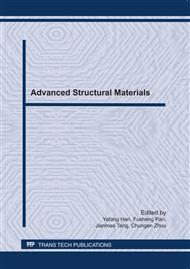[1]
A. Kampinsky and R. K. Ritt: Experimental and Theoretical Evaluation of a Passive Communications Satellite (ECHO II). NASA TN D-3154.
DOI: 10.1016/b978-0-08-011922-9.50016-6
Google Scholar
[2]
Houfei Fang, John Huang, and Ubaldo Quijano: Design and Technologies Development for an Eight-Meter Inflatable Reflectarray Antenna. AIAA 2006-2230. presented at 47th AIAA/ASME/ASCE/AHS/ASC Structures, Structural Dynamics, and Materials Conference, Newport, Rhode Island, 1-4 May (2006).
DOI: 10.2514/6.2006-2230
Google Scholar
[3]
T. Mann, V. Behun, D. Lichodziejewski and B. Derbes: Ground Testing a 20-meter Inflation Deployed Solar Sail. AIAA 2006-1707.
DOI: 10.2514/6.2006-1707
Google Scholar
[4]
K. Senda, N. Kishimoto, K. Higuchi, and et al: Finite Element Method Analysis and Experiment of 2-Dimensional Deployable Membrane Structures Embedding Inflatable Tubes. AIAA 2008-(2054).
DOI: 10.2514/6.2008-2054
Google Scholar
[5]
P.E. Freeland: Significance of the Inflatable Antenna Experiment Technology. AIAA 1998-2104.
Google Scholar
[6]
K. Guidanean and G. Veal: An inflatable rigidizable calibration optical sphere. AIAA 2003-1899.
Google Scholar
[7]
J. F. Curran: BASE - Bubble Architecture Space Environments. AIAA 2006-7320.
Google Scholar
[8]
M. C. Lindell, Stephen J. Hughes, Megan Dixon, and Cliff E. Willey: Structural Analysis and Testing of the Inflatable Re-entry Vehicle Experiment (IRVE). AIAA 2006-1699. presented at 47th AIAA/ASME/ASCE/AHS/ASC Structures, Structural Dynamics, and Materials Conference, Newport, Rhode Island, 1-4 May (2006).
DOI: 10.2514/6.2006-1699
Google Scholar
[9]
F. C. Bruhna, H. Kratza, J. Warellb, and et al.: Apreliminary Design for a Spherical Inflatable Microrover for Planetary Exploration. Acta Astronautica 63(2008)618-631.
DOI: 10.1016/j.actaastro.2008.01.044
Google Scholar
[10]
D. Lichodziejewski and Dr. Robin Cravey: Inflatably Deployed Membrane Waveguide Array Antenna for Space. AIAA 2003-1649. presented at 44th AIAA/ASME/ASCE/AHS Structures, Structural Dynamics, and Materials Conference, Norfolk, Virginia, 7-10 April (2003).
DOI: 10.2514/6.2003-1649
Google Scholar
[11]
J. S. Lew and L. G. Horta: Parametric Uncertainty Quantification of an Inflatable/ Rigidizable Hexapod. AIAA 2004-1826.
DOI: 10.2514/6.2004-1826
Google Scholar
[12]
K.T. Berger, L.G. Horta and B.K. Taleghani: Static Testing of an Inflatable/Rigidizable Hexapod Structure. AIAA 2004-1801.
DOI: 10.2514/6.2004-1801
Google Scholar
[13]
F. H. Redell and D. Lichodziejewski: Power-Scalable Inflation-Deployed Solar Arrays. AIAA 2004-1572. presented at 45th AIAA/ASME/ASCE/AHS/ASC Structures, Structural Dynamics & Materials Conference. Palm Springs, California, 19-22 April (2004).
DOI: 10.2514/6.2004-1572
Google Scholar
[14]
H. Furuya, and Y. Yoshida: Properties of Plainly Composed Inflatable Panels. AIAA 2008-(2050).
Google Scholar
[15]
G. Veal and R. Freeland: In-Step Inflatable Antenna Description. AIAA 1995-3739. presented at AIAA 1995 Space Program and Technologies Conference, Huntsville, AL, 26-28 September (1995).
DOI: 10.2514/6.1995-3739
Google Scholar


